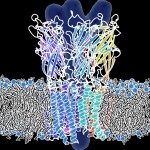Link to Pubmed [PMID] – 24394410
Link to HAL – Click here
Link to DOI – 10.1074/jbc.M113.538660
J. Biol. Chem. 2014 Feb;289(7):4367-76
We previously showed (Li, L., and Carter, C. W., Jr. (2013) J. Biol. Chem. 288, 34736-34745) that increased specificity for tryptophan versus tyrosine by contemporary Bacillus stearothermophilus tryptophanyl-tRNA synthetase (TrpRS) over that of TrpRS Urzyme results entirely from coupling between the anticodon-binding domain and an insertion into the Rossmann-fold known as Connecting Peptide 1. We show that this effect is closely related to a long range catalytic effect, in which side chain repacking in a region called the D1 Switch, accounts fully for the entire catalytic contribution of the catalytic Mg(2+) ion. We report intrinsic and higher order interaction effects on the specificity ratio, (kcat/Km)Trp/(kcat/Km)Tyr, of 15 combinatorial mutants from a previous study (Weinreb, V., Li, L., and Carter, C. W., Jr. (2012) Structure 20, 128-138) of the catalytic role of the D1 Switch. Unexpectedly, the same four-way interaction both activates catalytic assist by Mg(2+) ion and contributes -4.4 kcal/mol to the free energy of the specificity ratio. A minimum action path computed for the induced-fit and catalytic conformation changes shows that repacking of the four residues precedes a decrease in the volume of the tryptophan-binding pocket. We suggest that previous efforts to alter amino acid specificities of TrpRS and glutaminyl-tRNA synthetase (GlnRS) by mutagenesis without extensive, modular substitution failed because mutations were incompatible with interdomain motions required for catalysis.

